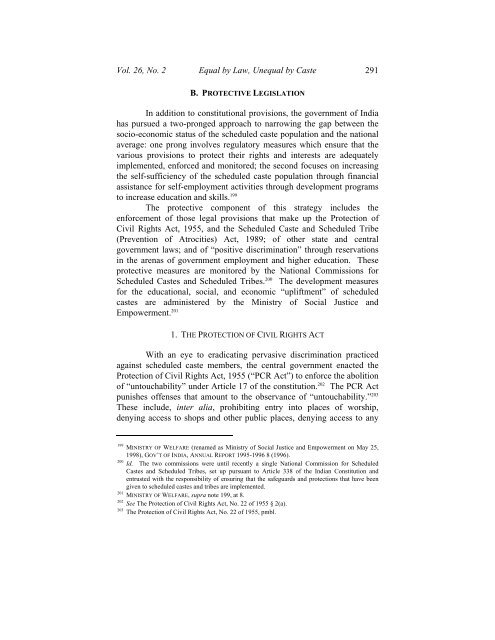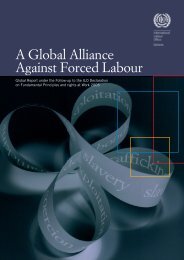equal by law, unequal by caste - International Dalit Solidarity Network
equal by law, unequal by caste - International Dalit Solidarity Network
equal by law, unequal by caste - International Dalit Solidarity Network
You also want an ePaper? Increase the reach of your titles
YUMPU automatically turns print PDFs into web optimized ePapers that Google loves.
Vol. 26, No. 2 Equal <strong>by</strong> Law, Un<strong>equal</strong> <strong>by</strong> Caste 291B. PROTECTIVE LEGISLATIONIn addition to constitutional provisions, the government of Indiahas pursued a two-pronged approach to narrowing the gap between thesocio-economic status of the scheduled <strong>caste</strong> population and the nationalaverage: one prong involves regulatory measures which ensure that thevarious provisions to protect their rights and interests are adequatelyimplemented, enforced and monitored; the second focuses on increasingthe self-sufficiency of the scheduled <strong>caste</strong> population through financialassistance for self-employment activities through development programsto increase education and skills. 199The protective component of this strategy includes theenforcement of those legal provisions that make up the Protection ofCivil Rights Act, 1955, and the Scheduled Caste and Scheduled Tribe(Prevention of Atrocities) Act, 1989; of other state and centralgovernment <strong>law</strong>s; and of “positive discrimination” through reservationsin the arenas of government employment and higher education. Theseprotective measures are monitored <strong>by</strong> the National Commissions forScheduled Castes and Scheduled Tribes. 200 The development measuresfor the educational, social, and economic “upliftment” of scheduled<strong>caste</strong>s are administered <strong>by</strong> the Ministry of Social Justice andEmpowerment. 2011. THE PROTECTION OF CIVIL RIGHTS ACTWith an eye to eradicating pervasive discrimination practicedagainst scheduled <strong>caste</strong> members, the central government enacted theProtection of Civil Rights Act, 1955 (“PCR Act”) to enforce the abolitionof “untouchability” under Article 17 of the constitution. 202 The PCR Actpunishes offenses that amount to the observance of “untouchability.” 203These include, inter alia, prohibiting entry into places of worship,denying access to shops and other public places, denying access to any199 MINISTRY OF WELFARE (renamed as Ministry of Social Justice and Empowerment on May 25,1998), GOV’T OF INDIA, ANNUAL REPORT 1995-1996 8 (1996).200 Id. The two commissions were until recently a single National Commission for ScheduledCastes and Scheduled Tribes, set up pursuant to Article 338 of the Indian Constitution andentrusted with the responsibility of ensuring that the safeguards and protections that have beengiven to scheduled <strong>caste</strong>s and tribes are implemented.201 MINISTRY OF WELFARE, supra note 199, at 8.202 See The Protection of Civil Rights Act, No. 22 of 1955 § 2(a).203 The Protection of Civil Rights Act, No. 22 of 1955, pmbl.
















